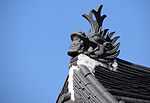Woljeongsa
| Woljeongsa | |
 One of the worship halls at Woljeongsa | |
| Korean name | |
|---|---|
| Hangul | 월정사 |
| Hanja | 月精寺 |
| Revised Romanization | Woljeongsa |
| McCune–Reischauer | Wŏljŏngsa |
Coordinates: 37°43′53″N 128°35′34″E / 37.731254°N 128.592653°E
Woljeongsa is a head temple of the Jogye Order of Korean Buddhism, located on the eastern slopes of Odaesan[1] in Pyeongchang County, Gangwon Province, South Korea. Woljeongsa was founded in 643 by the Silla monk Jajang.
Burned down and rebuilt a number of times, the last disaster was during the Korean War (1950–1953), when about ten buildings were burnt down by the Korean Army because it had become a refuge for the rebel forces.
Origin
It is said[citation needed] that, on this mountain, Master Jajang chanted before a stone statue of a Bodhisattva beside a pond, hoping to fulfill his wish to see a Manjusri Bodhisattva. On the seventh night after chanting he had a vision in which the Buddha gave him a poem with four lines in Sanskrit.

Next day, a monk came and remarked that the master looked pale and troubled. Master Jajang explained that he had received a poem he could not understand. The mysterious monk explained the verses and then told Jajang to go to Odaesan in Shilla where he would find 10,000 Manjusris. After seven more days of chanting, a dragon appeared who told Jajang that the old monk had been a Manjusri and that now he must go and build a temple to the Bodhisattva.
In 643 CE, Chajang reached Odaesan, but the mountain was so veiled in fog that he couldn't see anything. During the three days that he waited he built a thatched hut which eventually became the site of Woljeongsa temple.
Temple layout

In the Main Hall there is a statue of Gautama Buddha, but the more important statue is of an unusual Bodhisattva, 1.8 meters high, probably Medicine Buddha. Said to have been found in the Diamond Pond to the south of the temple, the statue is offering to an unknown figure. The statue is wearing a crown, the face is long, and the ears are slightly hidden by the long hair.
Around the neck there are three lines which are carved to look like necklaces. The elbow is resting on the head of a young boy. Because of its unusual style, the statue is thought to have been carved in the 11th century by craftsmen belonging to a special sect.
Nine Story Stone Pagoda

Woljeonsa'a Octagonal Nine Story Stone Pagoda, called the Sari-pagoda (relic pagoda) believed to have been constructed in the 10th century, is a multi-angled stone pagoda standing 15.2 meters/50 foot high and is representative of the multi-storied pagodas popular during the Goryo Period, especially in the northern regions of Korea.
The presently exposed stone base is not the original, with the original now being below the surface. A flat stone base has been laid over the original base and is carved with lotus flowers and other images.
Pillars are delicately carved into each corner of the upper face of the stone. The shape of the first tier and the door-frame images on all sides of the stone body along with the horizontal roof stone is representative of the Goryeo Period.
The roof and body stone structure of the nine stories gives this pagoda a feeling of stability. The thin body, curved corners, door-frame on the lower body and the variations in the octagonal shape illustrate the unique and aristocratic characteristics of the Goryeo era Buddhist culture.
Woljeonsa'a Octagonal Nine Story Stone Pagoda is National Treasure number 48.
Gallery
-
Tunnel of lanterns at Wolijeongsa's entrance
-
Woljeongsa's Octagonal Nine Story Stone Pagoda stands in front of the main worship hall
-
Stone Lantern at Wolijeongsa
-

Worship halls at Wolijeongsa, located on the eastern slopes of Odaesan
-
Ceiling of the entrance gate at Wolijeongsa
-
One of the entrance gates at Wolijeongsa
-
Buddha in one of the worship halls at Wolijeongsa
-
Image in relief on one of the entry gates at Wolijeongsa
| Wikimedia Commons has media related to Woljeongsa. |
See also
- Jajang
- Korean Buddhism
- Korean architecture
- Korean Buddhist temples
- List of Korea-related topics
References
- ↑ Lee, Cin Woo (16 March 2012). "Beyond Seoul: 19 reasons to explore Korea". CNN Go. Retrieved 6 May 2012.






